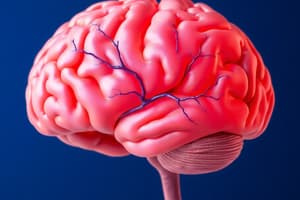Podcast
Questions and Answers
What are the 5 modern methods of studying the brain?
What are the 5 modern methods of studying the brain?
EEG, CAT, MRI, fMRI, PET
Who was Phineas Gage?
Who was Phineas Gage?
A patient who underwent an accident that drastically changed his personality, providing insight into brain function.
What was the unexpected consequence of the bilateral mesial temporal lobe resection performed on Henry Molaison?
What was the unexpected consequence of the bilateral mesial temporal lobe resection performed on Henry Molaison?
A severe compromise of Molaison's anterograde memory.
What did Roger Sperry's split brain experiments demonstrate?
What did Roger Sperry's split brain experiments demonstrate?
The left hemisphere is dominant for language.
The left hemisphere is dominant for language.
Jill Bolte Taylor is known for her work on the effects of a _____ stroke.
Jill Bolte Taylor is known for her work on the effects of a _____ stroke.
What did the cutting of the corpus callosum aim to achieve?
What did the cutting of the corpus callosum aim to achieve?
What did Joe's case in the split brain experiment illustrate?
What did Joe's case in the split brain experiment illustrate?
What is the main function of the limbic system?
What is the main function of the limbic system?
Flashcards are hidden until you start studying
Study Notes
Brain Structures and Functions
- The brain is divided into four primary hemispheres, each with distinct functions including control of movement, sensory processing, and higher cognitive functions.
- The limbic system plays a critical role in emotions and memory, comprising structures such as:
- Thalamus: Acts as a relay station for sensory information.
- Hypothalamus: Regulates hunger, thirst, and body temperature; controls the endocrine system.
- Hippocampus: Essential for the formation of new memories and spatial navigation.
- Amygdala: Involved in the processing of emotions, particularly fear and pleasure.
- The corpus callosum connects the left and right hemispheres, facilitating inter-hemispheric communication.
Modern Methods of Studying the Brain
- Brain imaging techniques to study brain activity and structure include:
- EEG (Electroencephalogram): Measures electrical activity; useful for diagnosing epilepsy but limited in spatial resolution.
- CAT (Computed Axial Tomography): Provides cross-sectional images of the brain; good for detecting structural anomalies but exposes patients to radiation.
- MRI (Magnetic Resonance Imaging): Offers high-resolution images of brain structures; non-invasive but time-consuming.
- fMRI (Functional MRI): Measures brain activity by detecting changes in blood flow; excellent for studying brain function, although not suitable for all patients.
- PET (Positron Emission Tomography): Visualizes brain activity through radioactive tracers; effective for identifying functional abnormalities but involves radiation exposure.
Case Studies Contributing to Brain Understanding
- Phineas Gage (1848): His severe brain injury led to changes in personality, providing insights into the role of the frontal lobe in personality and behavior.
- Henry Molaison (Patient H.M., 1953): Underwent a bilateral temporal lobe resection to treat epilepsy, resulting in profound anterograde amnesia. His condition advanced understanding of memory systems, particularly the role of the hippocampus.
- Jill Bolte Taylor (1996): A neuroanatomist who experienced a stroke, which provided a firsthand perspective on brain function and recovery, emphasizing the role of the left hemisphere in language and the right in non-verbal functions.
- Roger Sperry (1968): Conducted split-brain experiments, revealing that each hemisphere specializes in different functions. His Nobel Prize-winning work illustrated how severing the corpus callosum affects communication between the hemispheres, leading to unique behaviors in split-brain patients.
Split Brain Explanation
- Split-brain research demonstrated that the left hemisphere is dominant for language, allowing individuals to name objects in the right visual field easily.
- Objects presented in the left visual field evoke awareness without verbal recognition, showing that the right hemisphere can process information without communication to the left.
- Examples include patients successfully selecting objects with their left hand when stimuli are presented to the left visual field, indicating independent processing in each hemisphere.
- This phenomenon suggests the existence of two separate conscious agents, each capable of processing and responding to information in unique ways, although alternative interpretations may exist regarding vocalization challenges.
Studying That Suits You
Use AI to generate personalized quizzes and flashcards to suit your learning preferences.




